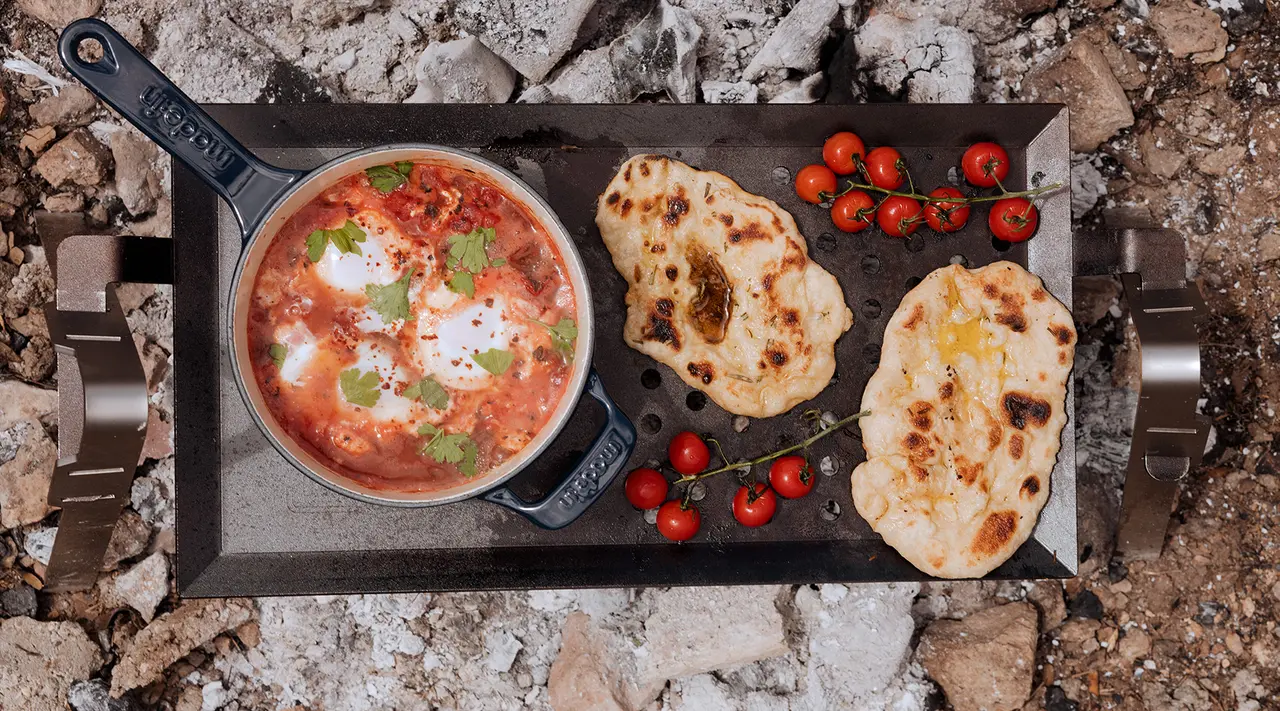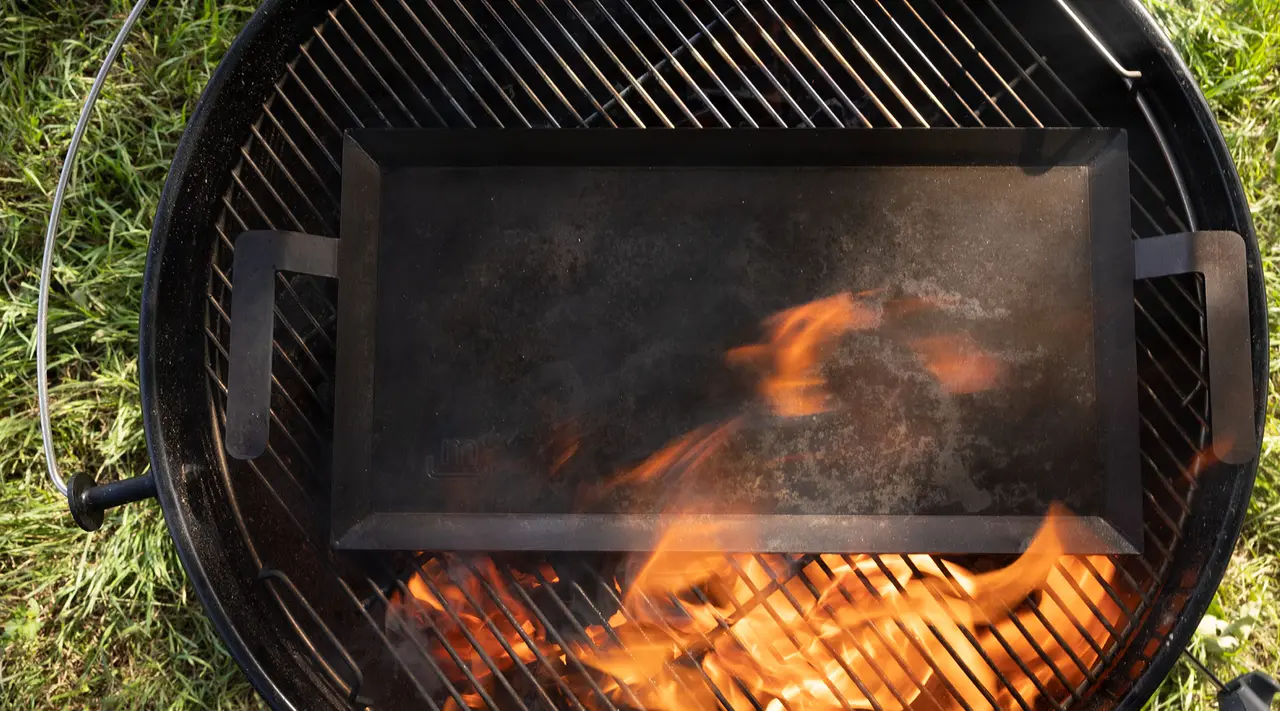Besides the walk-in, the best part of a diner kitchen is the flat griddle cooktop used to sear, sauté, and grill up large batches of hash browns, pancakes, paninis, and more. Offering a generous surface area with plenty of space for flipping and tossing food, a griddle is pretty unbeatable when it comes to getting a deep brown, savory crust on your food.
But since not every home kitchen can be retrofitted with one, portable griddles are designed to fill the same purpose but in a less permanent way. From frying up the perfect sunny side-up egg to getting a flawless sear on sausages, steaks, and burgers, read on to learn everything the griddle can do—and how to get the most out of it.
What Is a Griddle?

Thought to have originated in 104 A.D. in Ancient Rome, griddles play an essential role in food cultures as far flung as South Asia (see the round, concave tawa); Mexico (the comal); Japan (the teppan), and of course, the classic American diner (the flattop griddle). You’ll find them in many modern-day restaurant kitchens as well, where they’re used for cooking large volumes of food simultaneously.
Griddles come in nearly every material you can think of, most commonly non stick, stainless steel, carbon steel, or cast iron. You can choose portable griddles that fit over the burners on your stove, freestanding outdoor griddles, and electric griddles that sit on your countertop.
However, we think that a carbon steel griddle—ideally one large enough to fit over two burners, like ours—offers the best bang for your buck: not only is it naturally non stick when seasoned, but it’s also often portable, lightweight, and provides stellar heat circulation and retention. Bonus points if you choose one that (also like ours) has raised, ergonomically designed handles for easy carrying.
Benefits of Using a Carbon Steel Griddle
Whether you’re cooking steaks, salmon, or a brunch menu’s worth of bacon and eggs, you’ll want a griddle that heats evenly, retains heat well, and responds quickly to adjustments in temperature—and nothing ticks those boxes quite as well as carbon steel.
In addition to circulating heat evenly across the surface of the griddle, carbon steel also retains heat better than stainless steel, gets hotter than non stick, and weighs considerably less than cast iron. Essentially, carbon steel offers the best of all three (plus, it’s naturally non stick once seasoned). It’s also extremely durable, so it can stand up to years of high heat cooking.
A double-burner carbon steel griddle, like ours, is also incredibly versatile. Since it’s heat-resistant up to 1200F, you can safely use it on the grill, over a campfire, or even atop a fire pit—and because carbon steel is so responsive, you can easily control the temperature of your griddle by turning down the heat or moving it to a cooler part of the grill or fire.
This means you can do way more with your griddle than burger or breakfast duty—while it’s great at those as well, we also love it for everything from sautéing vegetables to searing whole fish and shellfish.
How to Use a Griddle

Your griddle is basically ready to use straight out of the box—especially if it comes pre-seasoned (if yours does not, check out our guide to help you season). Just give it a quick wipe to remove any dust that may have accumulated during shipping or manufacturing, then you’re ready to move on to the next steps.
On the Stove
To set up your griddle on the stove, first make sure that it fits evenly over two burners: we find that placing our griddle vertically works best, but it really depends on your stove. Our Carbon Steel Griddle is compatible with all stove types, including gas, electric, and induction.
Once your griddle is set up, it’s time to crank up the heat. One of the best parts of using a double-burner griddle—other than the larger cooking surface—is the fact that you can use it for dual zone cooking. If you’ve ever cooked over a grill, you’re probably familiar with this method, which involves maintaining a hotter section of the grill surface for searing and a cooler zone for keeping ingredients warm or to finish cooking them over gentle heat. The same principle basically applies to using a double-burner griddle.
Atop the Grill
Using your griddle on the grill gives you a flat, even coking surface, perfect for searing smashburgers.
Before preheating the grill, position your griddle on top of the grates. We recommend cleaning the grates first to prevent flare-ups from grease or other residue, and to help your griddle sit evenly.
- For gas grills, preheat to medium or high, depending on what you’re cooking. For charcoal grills, add enough charcoal to generate a medium to high heat.
- If you’re dual zone grilling, position the griddle evenly over the two heat zones. Move your fully cooked food from the hotter zone to the cooler zone to stay warm, or to slow down the cooking process and prevent burning or overcooking.
Once your griddle has fully cooled, carefully pour off any extra grease. Then, give it a quick rinse with water and a paper towel or dish cloth. If there’s anything left after wiping—such as burnt-on food or oil—you can use a bench scraper or spatula to scrape off any burnt-on messes. Note that you may have to reseason the griddle afterward if you end up scraping it to clean.
Over an Open Flame
Cooking with an open flame can be incredibly rewarding, if slightly more unpredictable than other methods. That’s why we love using our Carbon Steel Griddle when cooking over campfires and fire pits: since it distributes heat so evenly, it helps cook your food at a relatively steady rate (plus, you can easily move it from a hotter part of the fire to a cooler one).
Similar to other open fire cooking methods, using your griddle over an open flame requires a working knowledge of fire building and maintenance. You’ll need fuel—such as firewood, kindling, or charcoal—as well as a pair of extra-long, wood- or silicone-handled tongs and a spatula.
Once you’ve got your fire set up, you can either place the griddle directly on top of the charcoal or firewood, or use an adjustable griddle stand like the one in our Grill Griddle System to customize the height, allotting even more control over the cooking process.
What Can You Cook on a Griddle?

We can’t think of many foods that wouldn’t taste great coming off the griddle. Some of our favorite meals to cook on a griddle include seafood (hello, Gambas a la Plancha), quesatacos, crispy hashbrowns, and juicy lamb chops—basically, anything that benefits from quick, high heat cooking and a touch of char.
We also recommend getting creative: try grilling up pizza, oysters on the half shell, or even halved fresh peaches for a summery dessert.
Maintenance and Care for Your Carbon Steel Griddle

While carbon steel isn’t especially high maintenance, it does require a specific regimen of cleaning and care.
Cleaning Tips
You don’t need to scrub your griddle with soap and water after each use—and, in fact, you shouldn’t: too much scouring can damage or strip the layers of seasoning, which both maintain your griddle’s non stick properties and protect it from rust. Simply give your griddle a quick wipe down with a paper towel or dish cloth after it’s cooled down, then rinse it under running water (no soap!) to remove any lingering grease or residue.
Save the heavy duty cleaning methods for stubborn, burnt-on messes.
Re-seasoning
If you purchased an unseasoned carbon steel griddle, or you need to restore the seasoning after stripping it, we’ve got an easy, step-by-step guide to help you out.
Storage
The best way to keep your carbon steel griddle—or any carbon steel cookware—safe from rust and other damage is by making sure to reseason it whenever necessary. If you’re storing your pan for an extended period of time, we also recommend rubbing the outside with a bit of neutral oil before storing in a cool, non-humid environment.
Ready to Shop?
It's never a bad time to get acquainted with griddle cooking. Fast-heating, responsive, and large enough for dual zone cooking, our Carbon Steel Griddle makes every meal—from lazy Sunday breakfast to summer dinner parties—feel like something worth celebrating.































